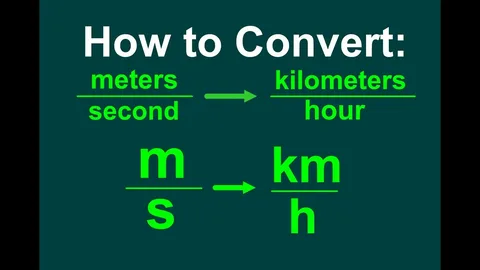Have you ever been told something is “378 meters away” and had no real sense of what that meant? You’re not alone. That’s exactly why learning how to convert meters to km makes everyday tasks easier.
Let’s break it down into real-life moments where this conversation actually makes a difference:
🏃 For Fitness & Running Goals
If you’re using a fitness app or smartwatch, it probably tracks your distance in meters. So if you’ve run 378 meters, how far is that in real running terms?
Well, it’s 0.378 kilometers—a bit over one-third of a kilometer. That’s good to know if you’re pacing for a 1K, 5K, or longer challenge. You’ll better understand how close (or far) you are from your goal.
🚗 For Driving & Navigation
You’re driving with GPS on and it says, “Turn in 400 meters.” Unless you’re used to metric, that might mean nothing. But when you convert that, it’s 0.4 kilometers. That’s easier to process while driving—especially if you’re used to seeing road distances in kilometers.
🛠️ For Building & Construction
Engineers and builders often work in meters for accuracy. But when you’re dealing with longer measurements—like site boundaries, cables, or road lengths—kilometers just feel easier to communicate. Saying “0.378 kilometers of piping” is cleaner than “378 meters of pipe”.
🌍 For Working Across Countries
Most countries use kilometers instead of miles. If you’re sharing documents, writing reports, or communicating with global partners, using kilometers is the standard. Converting meters to kilometers helps you sound clear, accurate, and professional.
And when you don’t want to deal with manual calculations? That’s where Whatever Converter becomes your go-to tool.
2. How to Convert 378 Meters to Km — The Easy Way
Let’s make this simple. To convert meters into kilometers, you only need to remember one thing:
1 kilometer = 1,000 meters
So here’s what you do:
Take your number (378 meters) and divide it by 1,000.
378 ÷ 1,000 = 0.378 kilometers
That’s it. No complex math. No need to overthink it.
And if you’re more of a “visual” person, just move the decimal three places to the left:
- 378 becomes 0.378 km
- 1,200 becomes 1.2 km
- 5,000 becomes 5.0 km
What Is 378 Meters Equivalent To?
Let’s give that number some meaning with real-world equivalents:
- 0.378 kilometers
- 0.235 miles
- 1,240.2 feet
- 413.4 yards
- 14,881.9 inches
- 37,800 centimeters
This means 378 meters is a little more than a quarter mile or around three and a half football fields. Next time you see 378m on your app or a sign, you’ll actually understand the distance.
Want to skip the math? Just head over to Whatever Converter, pop in your number, and get the result instantly—plus see it in feet, miles, inches, or whatever you need.
Handy Table: Meters to Kilometers at a Glance
Need to convert a bunch of numbers quickly? Here’s a quick reference table:
| Meters | Kilometers |
|---|---|
| 10 | 0.01 |
| 20 | 0.02 |
| 30 | 0.03 |
| 40 | 0.04 |
| 60 | 0.06 |
| 70 | 0.07 |
| 80 | 0.08 |
| 90 | 0.09 |
| 200 | 0.2 |
| 300 | 0.3 |
| 378 | 0.378 |
| 400 | 0.4 |
| 600 | 0.6 |
| 700 | 0.7 |
| 800 | 0.8 |
| 900 | 0.9 |
| 1,200 | 1.2 |
| 1,500 | 1.5 |
| 2,000 | 2.0 |
| 5,000 | 5.0 |
| 10,000 | 10.0 |
Save this table or just let Whatever Converter handle it in seconds.
3. Common Questions About Converting 378 Meters to Km
Let’s go over some of the questions people often ask:
✅ How many kilometers is 378 meters?
Easy answer: 0.378 kilometers. Just divide 378 by 1,000.
✅ Which is longer: 378 meters or 1 kilometer?
1 kilometer is longer. In fact, it’s more than 2.5 times longer than 378 meters.
✅ What’s more: 378 meters or 0.23 miles?
Here’s a fun one.
- 0.23 miles = about 370 meters
So, 378 meters is slightly longer than 0.23 miles. Surprising, right?
Bonus: Quick Tips to Make Meter-to-Km Conversions Easier
➤ Tip 1: Just move the decimal
To go from meters to km, shift the decimal three places left.
Example:
- 378m = 0.378km
- 1,000m = 1.000km
- 2,500m = 2.5km
➤ Tip 2: Track pace more easily
If you’re running or walking, and you know the distance in km, you can calculate your pace per kilometer much better than in meters.
➤ Tip 3: Use tech to your advantage
Your phone, watch, or fitness tracker probably gives you readings in meters. Convert them quickly into km with Whatever Converter and track your progress better.
Why Kilometers Are Used Around the World
Let’s rewind to history for a second. The metric system, which includes meters and kilometers, was introduced during the French Revolution. The goal was to make measuring simple, universal, and easy to scale.
Unlike feet or miles (which aren’t exactly round numbers), the metric system is clean:
- 100 cm = 1 meter
- 1,000 meters = 1 kilometer
It works great for everyday use, science, engineering, and communication across countries.
Today, almost every country in the world uses kilometers—so understanding how to convert from meters helps you stay clear and accurate, no matter who you’re talking to.
Final Words: Convert Meters to Km the Easy Way
In everyday life, we see meters all the time—on maps, signs, blueprints, apps. But when you understand how to convert Meters to Km, those numbers start to make a lot more sense.
Whether you’re training for a race, working on a project, planning a route, or just curious, knowing how far 378 meters is in kilometers gives you better control and confidence.
And if you ever want to skip the math?
✅ Head to Whatever Converter.
Enter your number → get your answer → done.
No confusion. No formulas. Just real-world understanding—fast.
Let me know if you’d like this turned into a PDF, infographic, or visual table for sharing. I’m happy to create that too!






